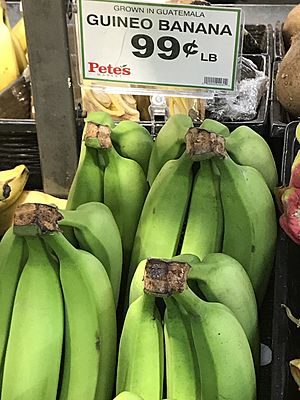Guineo facts for kids
Guineos (pronounced) usually refers to an unripe banana. The term guineo is sometimes used in reference to its ripened counterpart: the yellow (ripened) banana. Etymology of the word Guineo comes from Guinea, a country in the west of Africa, as it is one of the places from which bananas originate. Some make a distinction between the two and refer to green bananas as guineos verdes (green bananas) and yellow bananas as guineos (ripe bananas).
Guineos are not to be confused with plantains, which are far starchier than the guineo and cannot be used in the same ways.
Guineos are used widely in Latin American cooking as they are versatile, inexpensive, and filling.
Contents
Dominican Republic
Green banana are also commonly used in sancocho, mondongo and other soups.
Guineítos a dish where green bananas are boiled then sauteed with peppers and onions.
Mangú can also be made with green banana although this is less common.
El Salvador
Bananas whether green or ripe are called Guineos in El Salvador. Guineos are a popular fruit in the country and are used for the popular desert Chocobanano which is a frozen guineo covered in chocolate and sprinkles or other toppings on top.
Puerto Rico
In Puerto Rico cooking green bananas are used in dishes such as viandas con ajilimójili, pasteles, sopa de mondongo and sancocho. There are also many other dishes on the island which use green bananas. Green banana flour is widely available throughout Puerto Rico and used for making pancakes, crêpe, waffles, cookies, cake, tortilla, bread, and other pastries.
Asopao de Gandules (pigeon pea soup) is a pigeon pea, soup with dumpling made from green banana, squash and root tubers.
Ajo Pollo (egg and green banana dumplings soup).
Alcapurrias are a meat filled, fried fritters made from a mixture of grated yautía (eddoe root) and green bananas.
Arañitas (little spiders) are shredded plantains, cassava, or green bananas seasoned with garlic, cilantro, and salt, made into small patties and fried until crispy. They are normally eaten with mojo, with meals, or as a street food snack.
Escabeche is green bananas and chicken gizzards pickled in a garlicky brine with bay leaves, garlic, olive oil, onions, olives and other ingredients.
Guineo niño are green bananas boiled, mashed, mixed in a batter of flour, baking powder, milk, sofrito, herbs, spices and fried into balls.
Guineos verdes en fricasé (green banana fricassee). Green bananas cooked in a spicy tomato base fricassee sauce with recaíto, capers, chilies, and olives.
Jibarito envueltos are yellow finger bananas diced and sautéed in butter. Once the bananas are cooked they are then tossed into a blender with eggs, milk, coconut flakes, milk, flour, backing powder, sugar, and the option of spices. They are then formed into balls and fried. They can be eaten alone sprinkled cinnamon and nutmeg or with ice-cream.
Macabeos are green banana fritters. The bananas are boiled and mashed with annatto oil and a small amount of uncooked green banana. They are then filled with any meat of choice, made into small balls and deep-fried. This crescent shaped banana fritter is found mainly in the town of Trujillo Alto, which celebrates a Macabeo festival each year.
Serenata de Bacalao (salted cod with root vegetables). Salted cod fish mixed with tropical root vegetables, green bananas, cabbage, chayote, hard boiled eggs, and avocado. The boiled vegetables, green bananas, and chayote are then sauteed with peppers, much olive oil and vinegar. The cod is shredded and mixed in. The salad is then garnished with cilantro, eggs, avocado, and onions.
See also
 In Spanish: Guineo (banana inmadura) para niños
In Spanish: Guineo (banana inmadura) para niños


